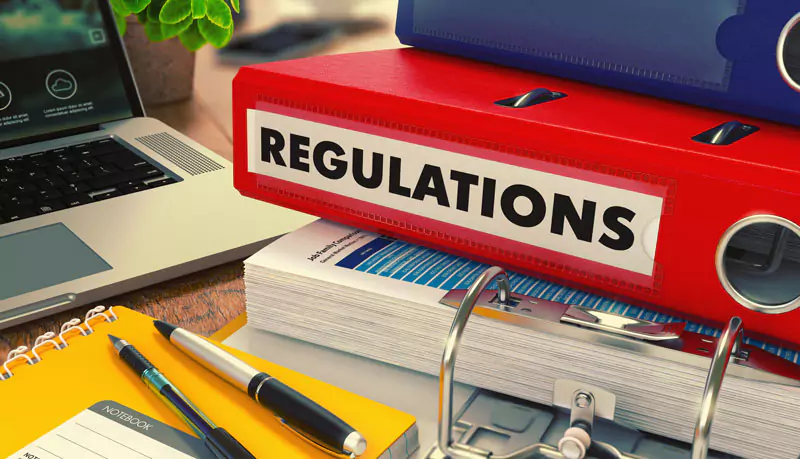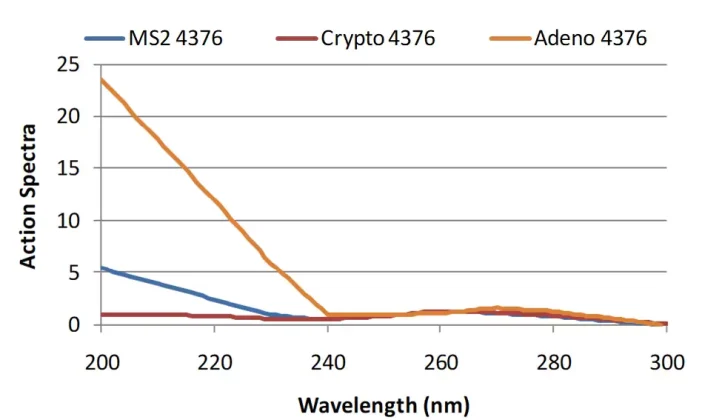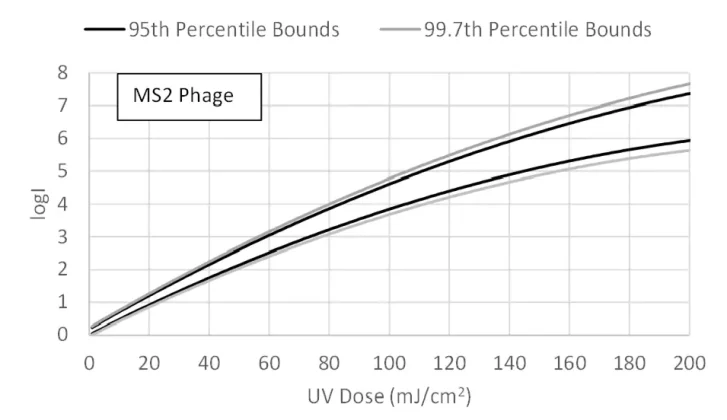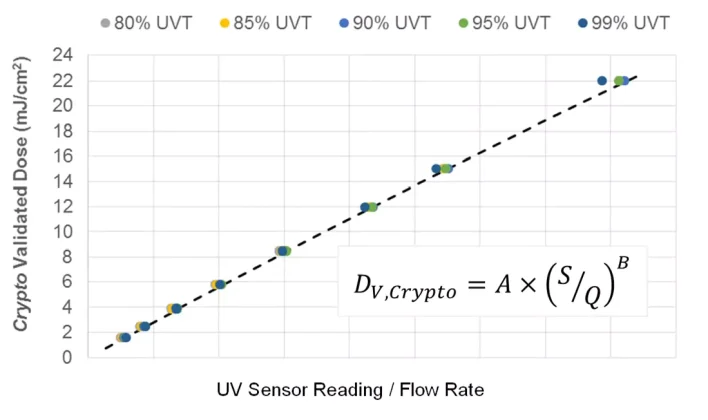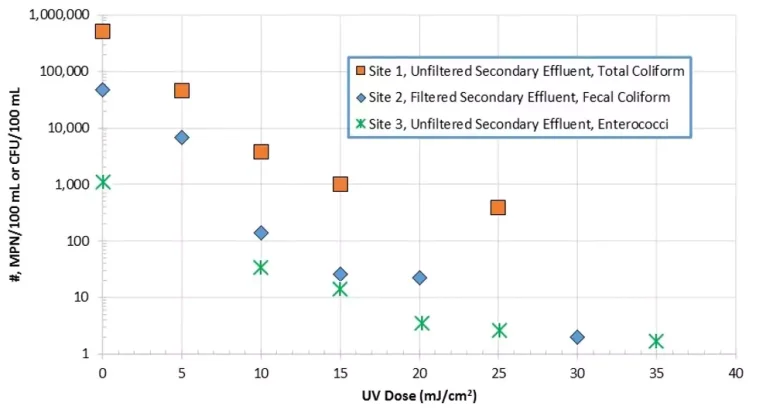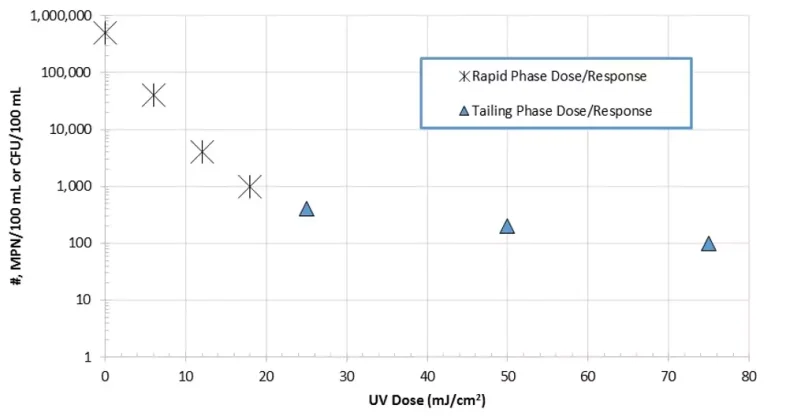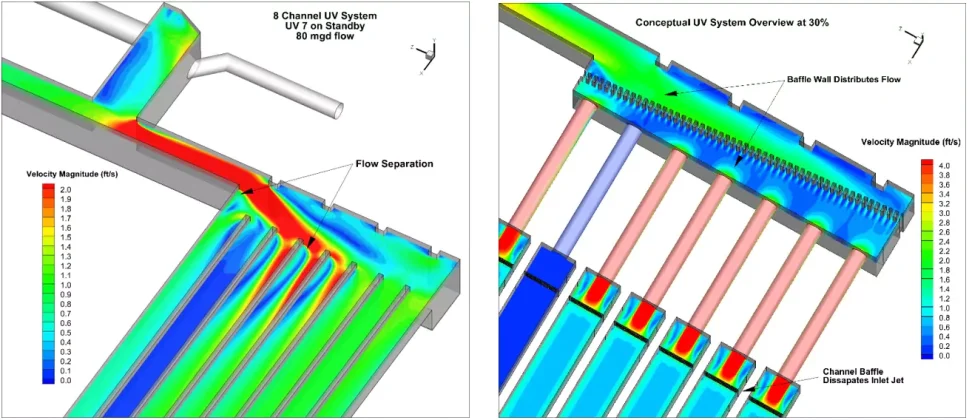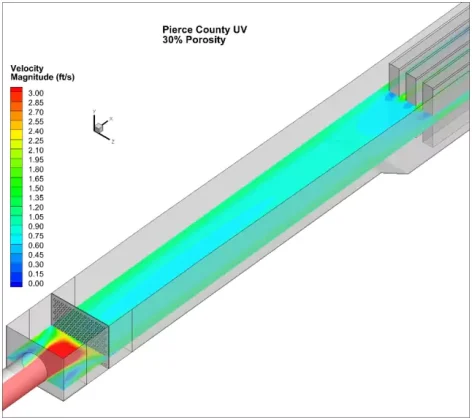Harold Wright
Chief Technologist-UV Disinfection, Carollo Engineers
Andrew Salveson
Water Reuse Practice Director, Carollo Engineers
Bill Sotirakos
Principal UV Technologist, Carollo Engineers
UV technologies play an important role in municipal water, wastewater and water reuse treatment, providing pathogen reduction through disinfection and chemical pollutant reduction through photolysis and advanced oxidation. This article, part one of a two-part series, reviews the applications and regulatory context for UV in municipal water and wastewater in the US. Part two will focus on potable and non-potable reuse applications.
Drinking water disinfection
While UV technologies have been used for drinking water disinfection in Europe since the 1950s, the technology was not considered for municipal drinking water treatment in the US until the discovery, in the late 1990s, that UV light was very effective against chlorine-resistant Cryptosporidium oocysts and Giardia cysts. In response to these findings, USEPA developed the Long Term 2 Enhanced Surface Water Treatment Rule (LT2ESWTR, published in 2006), which specified enhanced treatment of Cryptosporidium oocysts based on measured source water oocyst concentrations. In response, drinking water systems across the US have implemented UV disinfection for Cryptosporidium, Giardia and virus inactivation at flows ranging up to 2.24 billion gallons per day (BGD).
Regulations and guidance
The LT2ESWTR defined UV dose requirements for 0.5 to 4.0 log reduction of Giardia, Cryptosporidium and virus, based on UV dose-response of those microbes measured using a collimated beam apparatus equipped with a low-pressure (LP) UV lamp emitting UV light at 253.7 nm (see Table 1 for requirements). While Giardia and Cryptosporidium were sensitive to UV light, requiring a UV dose of 22 mJ/cm2 for 4 log reduction (99.99% reduction), the UV dose requirements for virus inactivation were based on adenovirus, a double-stranded DNA virus that uses host cell repair mechanisms to reverse damage caused by UV light. For that reason, the UV dose for 4 log reduction of virus was specified as 186 mJ/cm2, a UV dose value notably greater than the 40 mJ/cm2 requirement specified by other organizations (e.g., DVGW, ONORM, NSF) for 4 log pathogen removal, including virus.
The LT2ESWTR also specified that UV systems used for drinking water disinfection use UV dose monitoring algorithms that were proven using validation testing. With UV validation, a UV reactor is installed within a test train and operated over a range of flows, UV transmittance of the water and lamp power settings.
At each test condition, UV sensors’ readings and the log inactivation of a test microbe, such as MS2 phage, are measured. The log inactivation is related to a UV dose value, referred to as the Reduction Equivalent Dose (RED) using the microbe’s UV dose response, measured using a collimated beam apparatus equipped with an LP UV lamp. The resulting dataset is then analyzed to define the monitoring algorithm for the UV reactor.
To support the application of UV disinfection, USEPA worked with industry stakeholders to develop the UV Disinfection Guidance Manual (UVDGM), published in 2006. The UVDGM provided background on the science of UV disinfection and guidance on UV system planning, design, validation and operation. Because there was limited experience with municipal drinking water UV disinfection in the US prior to 2006, the authors of the UVDGM drew from the German DVGW and the Austrian ONORM rules and guidelines to define UV dose monitoring and validation. Those rules and guidelines, however, specified that UV systems deliver a B. subtilis spore RED of 40 mJ/cm2, monitored using a validated UV intensity setpoint approach using UV sensors with prescribed dimensions and properties. In contrast, UV systems in North America were using UV dose algorithms that reported UV dose values calculated as a function of measured flow, UV transmittance (UV-T) and UV sensor readings and were using UV sensor designs that did not necessarily comply with DVGW and ONORM requirements. For these reasons, the UVDGM was written to allow flexibility in UV dose monitoring and validation, providing opportunities for UV system manufacturers to develop monitoring and validation optimized for the UV dose requirements of the LT2ESWTR.
Advances in UV Since 2006
The UVDGM recognized that MS2 phage, commonly used for UV validation prior to 2006, was not a good surrogate for regulated pathogens because MS2 REDs measured during UV validation overstated UV dose delivery to Cryptosporidium and Giardia and understated UV dose delivery to adenovirus. To address this issue, the UVDGM specified application of conservative RED bias correction factors to account for these differences but also provided incentives for using alternate microbes and UV dose algorithms that better predicted UV dose delivery for the target pathogens. In response, UV system manufacturers conducted UV validation using multiple microbes, such as T1UV and T7 phage, B. pumilus and A. brasiliensis spores, and even live adenovirus, and developed UV dose monitoring equations that incorporated the UV sensitivity of the target microbe. With these approaches, UV systems could be properly sized for the required UV dose for the target pathogen, minimizing, if not eliminating, the need to apply RED bias correction factors.
The UVDGM also anticipated issues with polychromatic UV systems by providing guidance on the use of action spectra correction factors (ASCFs) to address differences in the wavelength response of validation test microbes and regulated pathogens (Figure 1). These issues came to the forefront at the 2011 Paris IUVA World Congress, where data were presented by WEDECO showing that microbial inactivation measured with medium-pressure (MP) lamps was highly dependent on UV dose delivery at wavelengths below 240 nm. They showed that validation could be conducted using synthetic quartz sleeves and water types that maximized low wavelength UV dose delivery, but those benefits would not necessarily occur with the application of the UV reactor at the water treatment plant due to water UV absorbance, lamp aging and fouling that can occur at wavelengths below 240 nm.
Further compounding this issue was the observation that commercial UV sensors were not designed to provide good monitoring at those low wavelengths. Hence, the monitoring algorithms developed through validation would not indicate whether the low wavelength benefits that occurred during validation were not occurring at the water treatment plant.
To address this issue, the Water Research Foundation (WRF) funded three projects to understand and address these issues. The final report for WRF Project 4376 provided action spectra (wavelength response data) for commonly used validation tests, microbes and regulated pathogens; provided tables of ASCF values for general use with MP UV reactors; and provided guidance for calculating ASCF values specific to a given UV reactor and its validation using validated computational fluid dynamics (CFD)-based UV dose models. The ASCF values for general use were as high as 1.98 if validation conducted using MS2 phage was being used for Cryptosporidium or adenovirus credit and as high as 5.49 if validation conducted using adenovirus was used for adenovirus credit. The magnitude of these ASCF values highlighted the importance of this issue but also identified an opportunity, namely the need for low wavelength UV sensors and monitoring algorithms that account for low wavelength dose delivery.
In 2013, USEPA funded a project to 1) document advances in UV dose monitoring and validation developed since the publication of the UVDGM, 2) develop new approaches for UV dose monitoring that would take advantage of low wavelength benefits with MP UV systems and 3) demonstrate these approaches using LP and MP pilot reactors.
The results of this work underwent a detailed one-year review in 2018, coordinated by IUVA under the direction of Bryan Townshend of Black & Veatch. This document will serve as a complement to the UVDGM and provide utilities, engineers and regulators details on better implementing UV technologies. In particular, the document provides details on:
- UV dose values for 6 log inactivation of pathogens based on the data and analysis used to develop the UV dose requirements for the LT2ESWTR. These values are relevant for potable reuse UV applications that call for 6 log pathogen inactivation.
- QA/QC bounds for the UV dose-response of MS2, T1UV and T7 phage based on 486 UV dose-response curve measured by multiple labs over a 10-year period (Figure 2).
- Calculated UV dose monitoring algorithms with improved accuracy that eliminates the need to apply RED bias correction factors.
- UV dose monitoring algorithms that do not require an online UV-T monitor, thereby simplifying UV operation for small systems.
- UV dose monitoring algorithms for MP UV systems that use low wavelength UV sensors to account for UV dose delivery below 240 nm.
- Criteria for developing a robust validation test matrix, criteria for evaluating the quality of the UV monitoring algorithm developed through validation and standardized approaches for defining the validated range.
- Recommendations for UV system operation that improves the accuracy of monitoring at the water treatment plant.
Drinking water UV summary
In summary, the framework for implementing UV disinfection for drinking water applications in the US is well defined by the LT2ESWTR and the UVDGM. The final report for WRF Project 4376 and the approaches provided in the “Innovative Approaches” document provide an improved standard of care for UV monitoring and validation while providing opportunities for more cost-effective and simplified UV system implementation. There is a clear need for regulator training on UV system monitoring, validation and implementation, to present new approaches as well as to address misconceptions, e.g., 4 log adenovirus inactivation requires a UV dose of 186 mJ/cm2 with LP UV systems but only 120 mJ/cm2 with MP systems (FDA, 2015 Grade “A” Pasteurized Milk Ordinance).
Wastewater disinfection
UV disinfection is an established and proven technology for treating both filtered and unfiltered municipal secondary effluent. The selection of UV over other technologies, such as chlorination/chloramination, is often based upon safety, operational cost or concerns regarding disinfection byproducts and/or toxicity. The challenge faced as an industry for wastewater disinfection is the lack of uniform regulations by region, states or nationally. For most projects, the industry relies upon guidance, and not regulation, to properly engineer these types of UV systems.
Applications
Treated objectives are based upon National Pollutant Discharge Elimination System (NPDES) requirements for total coliform, fecal coliform, E. coli and/or enterococci, and vary dramatically depending on the state (e.g., California vs. Missouri) and concern about downstream contact (e.g., inland surface water vs. ocean discharge). Bacterial targets are commonly listed as Most Probable Number (MPN) or Colony Forming Units (CFU) per 100 milliliters (mL) of sampled water, and permit requirements can be based on an arithmetic or geometric means and often include a “not to exceed” (NTE) value. Example targets include:
- 2.2 total coliform MPN per 100 mL based upon a seven-day median. This target, often seen in California, targets discharge to an inland water body that has high potential for recreational contact or water supply.
- 126 and 394 E. coli CFU per 100 mL as a 30-day average and a daily maximum, respectively.
35 and 89 enterococci CFU per 100 mL as a 30-day average and a maximum, respectively. - 200 and 800 fecal coliform CFU per 100 mL as a 30-day average and a maximum, respectively.
The industry recognizes that some secondary processes are more challenging for UV disinfection (e.g., trickling filter compared to nitrifying activated sludge), and that filtration improves UV performance (e.g. continuous backwash, deep bed multi-media filters) by removing total suspended solids that cause tailing in the target microbe’s UV dose-response curve (example shown in Figure 4 on page 16).
Regulations and guidance
Requirements for municipal effluent disinfection are often performance-based; meaning that there is no preferred technology or design criteria (e.g., UV dose) but simply a requirement to meet the effluent treatment target for the indicator microbes. Two notable exceptions to this rule are:
- Specification of a minimum allowable UV-T. Some wastewater applications specify that the UV-T of the wastewater must be greater than 55%, under the premise that UV systems cannot operate effectively at lower UV-Ts. However, this is a misconception, since many UV systems have been validated and shown to deliver the required UV dose at UV-Ts below 55%.
- Specification of a minimum UV dose. An example of this would be setting a minimum UV dose of 50 mJ/cm2 along with an indicator microbe compliance target. These minimum dose requirements are often based upon obtaining virus as well as bacterial inactivation.
Prior to 2015, regulators and the industry did not have a robust guidebook for UV system validation, design and operation for effluent disinfection. In the absence of regulations or guidance, the industry often missapplied the National Water Research Institute (NWRI) UV Guidelines (NWRI, 2012)1, a document best applied to non-potable water reuse applications. To fill this void, in 2015, IUVA and WEF published “Ultraviolet Disinfection for Wastewater: Low Dose Application Guidance for Secondary and Tertiary Discharges” (WEF, 2015)2, detailing the key components of UV disinfection of treated municipal effluent. Of the many key components, the most relevant to this paper are the validation and design components, shown below.
- UV system validation – Key features of the Bioassay/Validation Protocol in WEF (2015), which builds upon the protocol efforts from Whitby et al. (2011)3, include:
- Tested systems must be equivalent in configuration and operation to commercial systems, including all components.
- Tested open-channel systems must be hydraulically scalable for larger applications.
- Tested closed-vessel systems are not scalable to larger reactors.
- Reactors must be validated with a test organism with similar UV inactivation kinetics as the target organism (e.g., T1UV surrogate for fecal coliform). Two test organisms can be used that have a UV dose response that brackets the UV dose-response of target indicator microbes.
- Validation is conducted at flows and UV-Ts that span the range that can occur with application of the UV system at the wastewater treatment plant. Flow is defined in gallons per minute per lamp (gpm/lamp) for open-channel systems and gpm for closed-vessel systems. UV-T at wastewater plants can range from <35% to > 75%.
- Use of validated equipment outside of the validated range (flow or UV-T) is not recommended.
- Validation using calibrated UV sensors is recommended for better dose control.
- Robust data sets are needed for statistical confidence in performance.
- Head loss, lamp aging and lamp sleeve fouling must be understood and demonstrated.
- Process design and system sizing – Key components of successful UV design in WEF (2015) include:
- Meeting permit. Reliably meeting permit requirements requires a clear understanding of a number of items, including:
- Indicator microbe UV dose-response. Collimated beam testing is recommended to identify the UV dose required to meet permit levels. Such testing quantifies the impact of effluent suspended solids on disinfection performance. A secondary effluent will exhibit a two-phase UV dose-response, with a rapid disinfection phase and a tailing phase, as shown in Figure 5. Should the tailing region be near the compliance target, UV may be challenged to reliably meet permit without upstream modifications (i.e., filtration). To be clear, filtration is not required ahead of UV to meet many disinfection goals. Repeated collimated beam testing and an understanding of UV feed water quality variability is recommended for identifying a required UV dose that provides reliable disinfection.
- Permit terms. For each project, understand the permit conditions and examine the potential for those to change in future permit cycles. A permit with an arithmetic mean requirement is more stringent than a geometric mean requirement. For example, the average of 75, 50, 50, 25, 35, 20 and 10,000 CFU/100 mL is 1,465 CFU/100mL, whereas the geometric mean is 85 CFU/100mL. For a compliance target of 200 CFU/100mL, the average would be out of compliance, whereas the geometric mean would be within compliance. Essentially, geometric means allow for periodic high excursions that may be the result of a plant upset, an abnormal peak flow or an equipment failure. Further, a permit without a not-to-exceed (NTE) value has much greater flexibility than one with an NTE value. The NTE value requires designing the UV system for two conditions: the average or geometric mean under the vast majority of operating conditions (i.e., flow and UV-T) and the NTE value under extreme conditions (peak flow, low UV-T).
- UV-T. In the past, many UV systems used for secondary wastewater application assumed a design UV-T of 65%. This approach led to substantial risk, either of not meeting permit if the actual UV-T was less than 65% or over spending on UV system capital if the actual UV-T was higher than 65%. High quality secondary effluents (e.g., nitrified activated sludge) often have UV-T values in excess of 65%, whereas lower quality secondary effluents (e.g., trickling filters) often have UV-T values less than of 55%. Industrial discharges (e.g., landfill leachate) into a wastewater plant can have a dramatic impact on UV-T, in some cases dropping the secondary effluent UV-T to below 35%. NWRI (2012) recommends collecting a minimum of three samples per day spaced equally over a minimum period of six months, including wet weather periods. The design UV-T is then defined as the lower 10th percentile value of the measured dataset.
- Flow. The UV system must be designed to hydraulically pass all flow, including peak flow identified by analyzing long-term flow data. The UV system must also be designed to meet permit requirements over the flow range. Redundant UV trains or reactors can be used to improve system reliability during peak flow or low UV-T events.
- Reactor selection. Use UV reactors that are validated over the range of UV-T and flow that occurs with the application. Verify the robustness of the validation data set, understanding that the most robust validations are based upon 50 to 75+ test conditions, with fewer test conditions needed for closed vessel reactors. °
- Hydraulics. Hydraulics, in this discussion, encompasses three components:
- Flow split. Large systems are typically designed with parallel trains of UV reactors. Providing good flow split among operating reactor trains is important for meeting permit requirements and providing efficient UV system operation, especially if the UV system uses a single flowmeter to measure the total flow. The design flow for the system should account for the flow split, and CFD models, as shown in Figure 6, are recommended for identifying hydraulic designs that provide a flow split within 5%. The design team can then use the flow split difference to increase the design capacity of the system by that predictable margin (e.g., 5% in this case).
- Approach hydraulics. The UV system hydraulic design should ensure the UV reactor delivers the required UV dose, as indicated by the validation testing. Upstream pipe bends, influent gates, valves, flow meters and other devices can create an uneven flow distribution at the reactor inlet that can lower UV dose delivered by the reactor. CFD models can be used to evaluate the flow distribution and identify inlet channel and pipe designs that provide efficient UV dose delivery.
- Head loss. Head loss through UV systems has two impacts, the first being on the overall hydraulic grade line (HGL) of the treatment plant, requiring an understanding of head loss through the UV system and components (e.g., valves, weirs, etc.) so that the treatment plant can pass flow during peak flow events. The second is the impact of water level on open-channel UV system performance (closed-vessel systems are always fully submerged). Open-channel UV systems, with a few exceptions, must maintain water level above the top lamp that is approximately half the centerline to centerline lamps spacing. Too much head loss can result in either (a) exposed lamps, reduced efficiency and fouled sleeves, or (b) excessive water depth over the top lamp resulting in UV system bypass and permit violation.
- Meeting permit. Reliably meeting permit requirements requires a clear understanding of a number of items, including:
Wastewater UV summary
UV systems have been successfully installed at wastewater treatment plants in the United States for more than 30 years. Experience shows that key factors that influence the long-term success of UV projects include:
- Design and installation of a validated system, providing confidence in system capacity and operation.
- Understanding of the value and variability of effluent quality prior to disinfection through repeated UV-T analysis and collimated beam dose-response testing.
Utilization of CFD design tools to optimize flow split and approach and exit hydraulics to the UV reactors. - Operation within the validated range of flow and UV-T.
Sampling at a reasonable distance downstream of the last operational UV bank, but before the effluent weir or level control structure. - Maintaining an aggressive channel and sleeve cleaning program, with the former minimizing biofilms and bacteria regrowth and the latter minimizing loss of UV intensity due to sleeve fouling.
Contact: Harold Wright, hwright@carollo.com; Andrew Salveson, asalveson@carollo.com; Bill Sotirakos, bsotirakos@carollo.com
References
[1] Ultraviolet Disinfection Guidelines for Drinking Water and Water Reuse. Third Edition. August 2012. Published by the National Water Research Institute in collaboration with the Water Research Foundation.
[2] Ultraviolet Disinfection for Wastewater. Low-Dose Application Guidance for Secondary and Tertiary Discharges. A joint publication by the Water Environment Federation and the International Ultraviolet Association. ISBN 978-1-57278-312-6.
[3] Whitby, G.E.; Lawal, O.; Ropic, P.; Shmia, S., Ferran, B.; Dussert, B. (2011). Uniform Protocol for Wastewater UV Validation Applications. IUVA News, 13 (2), 26-33.


